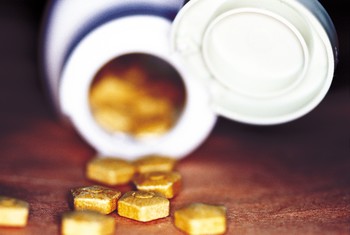 |
|
NanoCrystal technology targets poorly water-soluble drugs - In the field: Pharmaceutical Science & Technology news
NanoSystems, a unit of Elan Corporation, plc (Dublin, Ireland), has created "NanoCrystal" technology to reduce the particle size of poorly water-soluble drugs and increase the rate of dissolution. The reduction occurs by transforming poorly water-soluble drug candidates into nanometer-sized particles--usually less than 1000 nm in diameter through a milling process. The drug can then be incorporated into common dosage compounds such as tablets, capsules, inhalation devices, and sterile forms for injection. "A poorly water-soluble drug will take a long time to dissolve in the gastrointestinal fluids, and if the rate of dissolution is very slow, the drug may not dissolve completely before it's eliminated," says Richard Vickers, vice-president of commercial licensing for Elan Drug Delivery Inc. (King of Prussia, PA). With NanoCrystal technology, there is an increased amount of dissolved material, which, in turn, increases bioavailability. The company also believes that the lower concentration of active drug molecules can increase safety for the patient. "The drug concentration is usually proportional to side effects," says Vickers. "Minimizing the exposure to the active drug molecules typically minimizes side effects." Drug makers may also benefit from the use of NanoCrystal technology in drugs that must currently be taken with food. Because of the lower concentrations of active ingredients, FDA may, in the future, be willing to approve product labels that allow patients to take such drugs without restrictions. The lack of restrictions may be especially helpful for patients who take more than one medication per day at different times and have difficulty complying effectively because of complex dosing requirements. NanoCrystal technology also promises to improve drug dosage proportionality. According to Vickers, it's common for poorly water-soluble drugs to have different corresponding bioavailability and therapeutic responses. For example, a response from 100 mg of a drug may not necessarily be twice the response of a 50 mg dosage. Instead, doubling a dosage may result in only one-third or one-quarter of the response. However, by improving close proportionality, the drug level in the blood increases accurately, which makes the therapeutic effect more predictable. NanoCrystal particles are actually small particles of drug substance, produced by milling, and then stabilized against agglomeration by surface adsorption of selected generally regarded as safe (GRAS) stabilizers. The result is a suspension of the drug substance that behaves like a solution. Currently, there are two products on the market incorporating NanoCrystal technology. One is Wyeth's "Rapamune," a drug that is used for the treatment of transplant rejection and the other is Merck & Company's "Emend," a central nervous system drug which is currently approved for the treatment of nausea and vomiting associated with cancer chemotherapy. Emend is also in clinical trials for the treatment of depression. "One is a tablet and the other is a capsule," says Vickers. "However, any dosage form using a poorly water-soluble drug can benefit from the application of NanoCrystal technology." Some dosage forms currently in development from NanoSystems incorporating NanoCrystal technology include pulmonary delivery, intravenous or parenteral delivery, and other oral deliveries. According to Vickers, the existence of poorly water-soluble drugs is a significant problem in pharmaceutical development, but has been somewhat unrecognized. "It's currently estimated that anywhere from 30% to 60% of the molecules that are developed through pharmaceutical companies' research and development efforts are poorly water-soluble," he says. "The pharmaceutical industry is looking at this technology to help make these molecules useful for product development." |
Copyright 2025 Fstradio.com All rights reserved.
|

 An increasing number of drug candidates synthesized each year by pharmaceutical companies are considered poorly water-soluble. Most of these compounds are dropped from development because they can't be formulated properly. However, a new solution to poorly water-soluble drug candidates is now available and is aimed at improving bioavailability, dosage proportionality, and patient safety.
An increasing number of drug candidates synthesized each year by pharmaceutical companies are considered poorly water-soluble. Most of these compounds are dropped from development because they can't be formulated properly. However, a new solution to poorly water-soluble drug candidates is now available and is aimed at improving bioavailability, dosage proportionality, and patient safety.